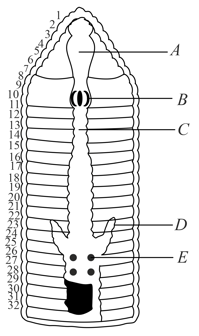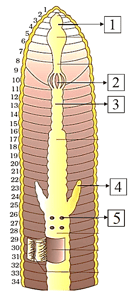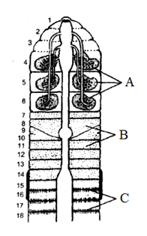Given is the figure of the alimentary canal of the earthworm. Select the option that correctly identifies the parts labelled as to .

(i)
Pharynx
Stomach
Caecum
Gizzard
Lymph gland
(ii)
Gizzard
Pharynx
Stomach
Caecum
Lymph gland
(iii)
Pharynx
Gizzard
Stomach
Caecum
Lymph gland
(iv)
Gizzard
Pharynx
Liver
Stomach
Villi

Important Questions on Structural Organisation in Animals
In the given diagram of the digestive system of earthworm, identify parts labelled as and select the correct option ?

(a) It serves as a covering for the mouth.
(b) It helps to open cracks in the soil into which it can crawl.
(c) It is one of the sensory structures.
(d) It is the first body segment.
A. Testes
B. Accessory glands
C. Spermathecae
D. Ovaries
Arrange them in a correct sequence from anterior end to posterior end.
Match the following features to the animals. Which is the correct combination?
Open circulatory system
Closed circulatory system
Earthworm
Malpighian tubules
Nephridia
Cockroach

(i) Septal nephridia
(ii) Integumentary nephridia
(iii) Tufts of pharyngeal nephridia
Represent the union of two sets by Venn diagram for each of the following.
is a prime number between and
is an odd number between and
Consider the following statements:
(i) The body wall of an earthworm is covered externally by a thin, non-cellular cuticle, below which lies epidermis.
(ii) The epidermis of an earthworm is made up of a single layer of columnar epithelial cells which contain secretory gland cells.
(iii) The setae are present in all segments of the body of earthworm.
(iv) Septal nephridia are present in first 14 segments in Pheretima.
Which of the above statements are correct?

